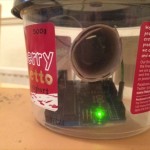Caveat: be careful with your expensive, delicate computer. This has all the characteristics of a hack, but it was wildly successful for me. There may also be a much more sensible way of doing this out there. YMMV.
I have a mid 2010 spec Mac Pro, with the 6 core Westmere chip. I’ve been running out of disk space for about half of the elapsed time since I upgraded to a SATA 2 SSD about 3 years ago. Amazon are doing a pretty good deal on a Samsung SATA 3 SSD at the moment so I thought I’d take a punt on upgrading.
The long and short of it is that I’ve hacked together a pretty cheap option, which has given me a 13x speed up on sustained write speeds.
I went for this card [which appears to have risen in price by a couple of quid since last week], on the basis of seeing a reference to a particular chipset [ASM1061] on a forum somewhere along the line.
I have to admit straight off the bat that I’d never worked with PCIE before, and it took me a while to work out that the card was missing a power supply. This led me on a merry dance to figure out how to get power into my SSD. There are a couple of raised interfaces on the card which may be power outlets, but I’ve never seen anything like them before. Having looked at a tutorial on how to install a USB 3 device, I thought I was going to end up having to take the fan out, and get some sort of MOLEX to Mac 4 pin style power adapter cable. Having then hit on the fact that your stock Mac Pro [of my era at least] comes fitted with a single occupied bay of 4 designed for hard drives with SATA [2] interfaces, I bought one of these. Here’s the really hacky bit: the extender cable comes with a couple of clips either side to stabilise the connection. You have to clip one of them off, and plug it into the SATA interface of your choice.
And it works. And it’s bootable [a gotcha for some PCIE cards], and it handles resurrection from sleep. I verified that it was registered as a SATA 3 [look for the negotiated link speed of 6 Gb/sec] and used BlackMagic Disk Speed Test to verify a sustained write speed of 354 Mb/sec.
While there are integrated cards that you slot your SSD straight into, this turned out to be cheaper. That said, the new SSD is currently sitting loose inside the machine. There are integrated ‘sleds’ that you can screw the SSD into, and then slide into one of the four disk bays. I haven’t seen one that’s less than about £20. I also haven’t experimented with any of the 3 spare interfaces [2 of which are external] on the card: I’ve no idea if you can RAID up two SSDs on the same card, for instance. I’d be interested to find out!

